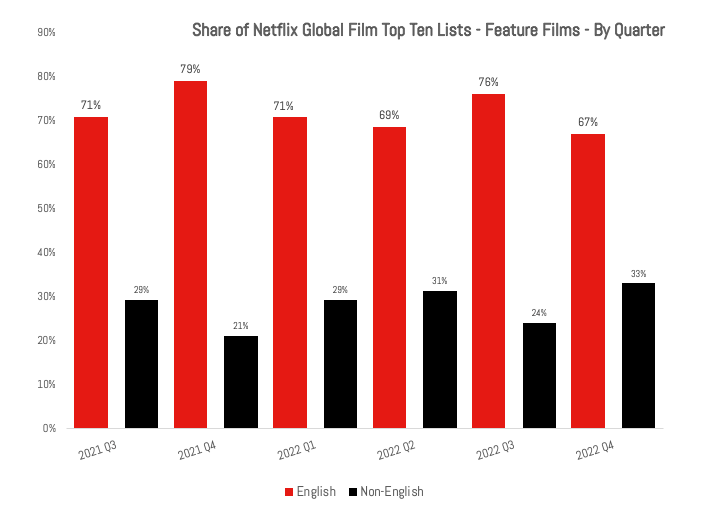Foreign Failures Part V
My Fifth (And Final) Look at How Foreign-Language Streaming Titles Have Underperformed (and Why This Matters)
So, last week, the Streaming Ratings Report ran a bit long and, since I don't want to go too long, I cut out this section, on foreign films, especially since it feels less like a streaming ratings article and more like a strategy column.1
Before that, though, I have a message to any and all P.R. execs at the major streamers. Next week, I’m publishing my annual column highlighting the flops, misses and bombs of 2022 (what I call “Dogs Not Barking”, explainer here.)
If you think that I may call a show a flop, but you have internal data/numbers that will prove me wrong, please email me this week to let me know. That said, I don’t want vague, incomplete datecdotes; I need actual data, along with comparisons to your other shows to put this data in context.
Back to the article. Last week, looking at all of the new releases, two new Netflix shows stood out to me: Copenhagen Cowboy and The Lying Life of Adults. These aren’t just notable titles from bigger-ish name talent (Nicholas Refn and Elena Ferrante, respectively); they’re foreign-language titles that should be hits!
But if you’ve been reading me for a while, now, you probably know where is going...
Today, I’ll be looking at foreign language films and TV shows, finishing off my “Foreign Failures” series 2022 and in the near future. (See here, here, here, here or here.) I probably won’t revisit this topic until there’s another foreign-language hit; I’ve said just about everything I want to say on this topic for now. The streaming wars are a global contest, but the data really seems to show that these films don’t travel.
Foreign Film (And TV) Failures in America of 2023
As I’ve done for the last few iterations of this feature, I open with an image or quote from one of Netflix’s foreign-language titles. Usually, I try to find from the most ridiculous title, poster or trailer I noticed compiling the IMDb scores. But in Q4 I don’t want to quite do that.
Check this out:
That’s Troll, Netflix’s best performing foreign-language film (in the first 28 days) according to global viewership.
But here’s the thing: I love this poster. It’s great! The movie looks good! Not award-winning or anything, but it looks like a fun, borderline-Kaiju monster flick. I instantly get it and kind of want to see it!2
(Not all the films were great. Netflix also released Who’s a Good Boy? this quarter…)
When it comes to foreign films, Netflix’s isn’t just pumping out forgettable, cheap foreign-language content; they’re also making notable foreign-language films and TV shows with real budgets. Like Troll, which doesn’t look cheap by any means. It doesn’t have a ginormous-Hollywood-blockbuster budget, but it’s not a “cheap” $2 million film.
In Q4 in particular, Netflix took some big swings. Big, big swings. Swings so big that I worried, after I first penned my skepticism about foreign-language titles in The Ankler in November, that one of these shows or films would be a huge hit and the “Toldja’s!” would come out in force.
Turns out, I didn’t have to worry. Most of those swings missed in the US:
Bardo, False Chronicle of a Handful of Truths - From Academy Award-winning director Alejandro Iñárritu, I declared this the “Dog Not Barking” of the week when it failed to make the Nielsen (or any other) charts. It’s also one of Netflix’s biggest film flops of the year, in any language. (Stay tuned for next week!)
Copenhagen Cowboy - From Nicholas Refn of Drive fame, this show failed to chart this week. (It only has 3.4K reviews on IMDb as of this writing.)
The Lying Life of Adults - From acclaimed Italian novelist Elena Ferrante— knowing literary rights prices, this wasn’t cheap—this show still has less than a thousand reviews on IMDb, which is terrible. And it didn’t chart this week.
Barbarians - In its second season, this show (which does not seem cheap) was also a DNB in America.
Elite - In its sixth season, this show also was a DNB.
Lost Bullet 2: Back for More - A sequel to one of Netflix’s first datecdotes, this too was a DNB in America.
Since so many of these titles miss the Nielsen rankings, I’ve taken to using the IMDb reviews as a proxy for quality in America. The results show a huge volume of misses:
Out of 34 original films released in November and December, Netflix only had seven rank above a 6.5 on IMDb. And fourteen of those lowly-ranked films had over a thousand reviews, which has to be terrible for brand loyalty. At some point, this strategy is probably hurting Netflix’s relationship with its customers since they’re recommending bad films to their customers. Like Troll. This title has over 40,000 reviews, but it has a score of 5.8, which is terrible.
On the TV side, things are a bit better. Of their 34 original foreign-language TV shows, only fourteen scored below a 6.5 on IMDb. That said, unlike the films, only fifteen got over a thousand reviews. Like I’ve written before, even if people like a TV show, Netflix isn’t showing the hits to customers or the customers don’t want to watch them.
(I’ve got the full chart of the titles from the last two months in the appendix. it’s just too big to put it up here!)
Netflix isn’t making these shows to get tax credits or satisfy quotes: they’re searching for global hits. Netflix makes TV shows with three potential audiences in mind: local-only hits, regional hits, and global hits. It’s that last category where Netflix struggles. If a foreign film or TV show comes out and it isn’t a hit in America (and often Europe), where over a third of Netflix's subscribers live, is it really a global hit?
During the big Squid Game narrative battle of 2021, when every analyst said that its success foretold a huge rise in foreign-language viewing in America, I skeptically raised my hand and said “I doubt it.” And the past year has mostly shown this to be the right call.
As Lucas Shaw noted recently, Netflix’s foreign-language titles really underwhelmed in 2022, calling it a “weak year” for them. In 2022, Netflix released hundreds of foreign-language originals, TV and film but in the U.S., at best, they had eleven TV series make the U.S. charts and twelve films make the chart. Of those titles, you could maybe call two (maybe three) of them legitimate hits. At best. (South Korea’s All of Us Are Dead, Norway’s Troll and maybe Columbia’s El Rey, Vicente Fernandez.3)
And it still seems like English-language shows still drive Netflix’s business. For the Ankler, back in November, I compared the total hours viewed on their top ten lists between English-language and foreign-language titles.
And while the data is noisy, it looks like if anything English-language titles gained share since Squid Game.
Making truly “global” hits is hard. Really hard. Given that one-quarter of Netflix’s audience is in America (and maybe a third or more is English speaking if you add in Canada, the UK and Australia), these foreign titles need to be hits in those markets too. Here, the Nielsen charts again show that the bulk of the content customers watch in America comes from English-speaking countries:
And remember: it’s not just American audiences who are foreign-language averse. As even I learned back in September, researching my article on Asian streaming markets for the Ankler, most people like watching TV shows in their native language or from their local region. It’s not just Americans; it’s everyone!
This is one of the bigger challenges to conquer in the streaming wars. Just read the most recent New Yorker profile on Bela Bajaria. The whole point of the article, from the title to the article itself, is that Netflix is global now. Meaning they have to make content for every region, and the data says this content doesn’t travel as well as initially hypothesized.
Even weirder, as happens so often in the streaming wars, all of the other streamers are racing to copy Netflix’s strategy, without even waiting to see if it’s working or not. As the year went on, Disney (ten in the last two months of the year), HBO Max (also ten shows, but they were so small, we couldn’t even find data on them) and Prime Video (eight) have released more and more foreign-language titles, most of which did much, much worse than the Netflix titles!
Even Paramount+ is running adds about all the foreign language titles they’ll be releasing in the next few years!
The Streaming Wars are Tough; The Global Content Wars May Be Tougher
As I wrote in the introduction, this is the last edition of “Foreign Failures” for now. I think I’ve made my point. (Or I hope I did; If I didn’t, I can’t really explain it any better.) I’m going to wait to write about this again whenever Netflix or someone else has their next truly global foreign-language hit.
Similar to my warnings, over the years, that streaming (especially with exclusive, non-theatrically-released films and binge-released TV shows) wasn’t a great business model (which everyone else figured out last year) or my fears about streaming killing movie theaters (more on this soon), I feel the same way about Hollywood’s global push; the data just isn’t there.
And yet nearly every streamer is leaning heavily into this strategy. Group think is bad; it’s worse when people are copying strategies that haven’t even proven themselves to be successful yet.
Just don’t say I didn’t warn you.
Appendix
For my free subscribers, this means you get more content than normal…BUT I can’t do this work without paying subscribers, so please consider subscribing.
Until I saw the IMDb scores.
Even this show originally aired on Caracol TV in Columbia; Netflix has the global rights.








